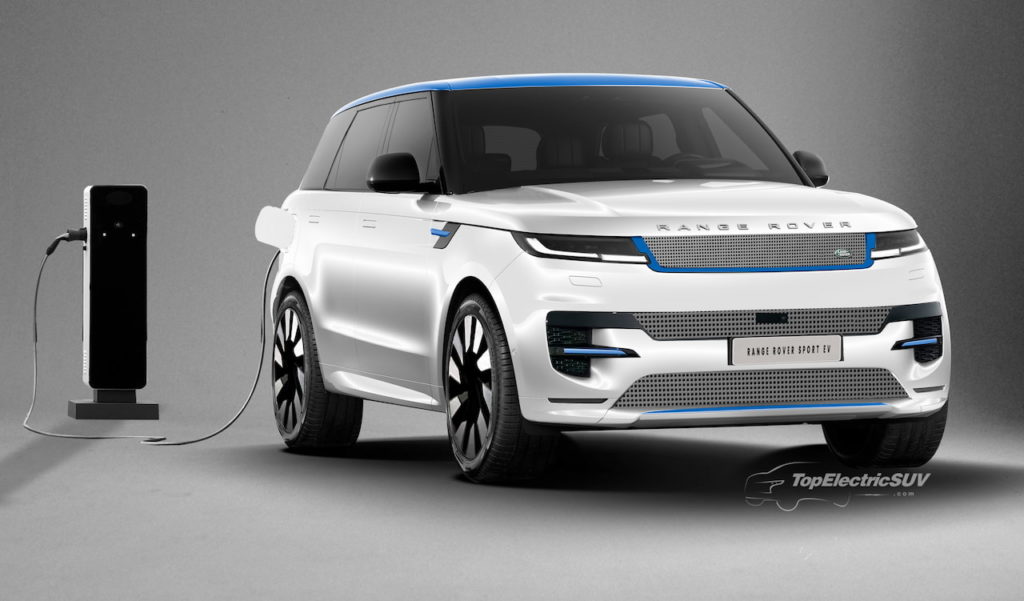Update: All sections updated.
Land Rover has confirmed that the Range Rover Sport Electric will be its second EV, following the all-electric Range Rover. Since the launch, the third-generation Range Rover Sport features partial electrification, and it is set to gain 100% electrification in 2025. Here’s everything we know about the upcoming electric SUV.
Design
The third-gen Range Rover Sport’s clean and reductive design is a good base for a pure-electric SUV, both aesthetically and technically. Land Rover has designed the vehicle to be as efficient as possible, which means minimal changes are required to transition the Range Rover Sport to its electric version. Fans would prefer the traditional design and styling of the Range Rover Sport, rather than an offbeat approach seen in models like the Tesla Model X or BMW iX.

The all-new Range Rover Sport (gas model) features flush glazing and door handles, a hidden waist rail finisher, the longest and largest spoiler ever fitted to a Range Rover, and a contoured underfloor design. These enhancements make it 15% more aerodynamically efficient than its predecessor, with a drag coefficient (Cd) of 0.29. Active Brake Cooling, which opens the ducts only when additional cooling is required for the brakes, also contributes to this figure.
The Range Rover Sport electric variant (rendered above) will build on this start with additional aerodynamic enhancements, such as a new upper grille, and specially designed 23-inch wheels. Based on the design strategy of the larger Range Rover EV, we don’t anticipate wholesale changes to the exterior of the electric Range Rover Sport.
Interior


The interior of the Range Rover Sport Electric is unlikely to differ greatly from the gas model. Designers could progressively introduce new sustainable materials, and exclusive trim and colors. Building on the donor model’s options, the electric variant will offer an extensive selection of sustainable materials, including lightweight Ultrafabrics. Both the 13.7-inch Interactive Driver Display and the Pivi Pro touchscreen infotainment system are expected to feature model-specific powertrain information and a special welcome screen tailored for the electric variant.
Specifications
Thanks to its smooth and silent powertrain, the Range Rover Sport Electric should become the quietest variant. Ideally, this vehicle should offer more comfort on the highway due to the battery pack mounted low on its floor. Likewise, the torquey nature of the electric powertrain should make driving in cities effortless, and the availability of one-pedal driving may make urban commutes easier.
Sharing the MLA Flex platform with the Range Rover EV, we expect it to have similar powertrain components, while differently calibrated. Land Rover should use the new traction control system, enhancing torque vectoring for better off-road capability.


The Range Rover Sport Electric could launch with a 90-100 kWh battery pack that offers an EPA-estimated range of around 300 miles. Land Rover could offer two motors, one at the front and one at the rear, as standard. The company may offer at least two output levels to cater to both economy-focused and performance-focused customers while ensuring its product is competitive enough compared to rivals from Mercedes, Audi, Tesla, and luxury brands.
Land Rover plans to position electric variants above the gas models. Besides the environmental benefits, it should also seem more capable, justifying a premium price. Expect at least one variant to produce close to 630 hp, surpassing the current 626 hp P635 model. Torque could exceed the P635’s 553 lb.-ft., possibly reaching 600 lb.-ft., with a 0-60 mph time of around 3.5 seconds (compared to the P635’s 3.6 seconds).
With the newly developed 800V electrical architecture, the Range Rover Sport should charge from 10-80% in 20-25 minutes. Land Rover will use SiC semiconductors from New York-based Wolfspeed in the inverters of its next-gen EVs.
Rivals
The Range Rover Sport Electric would compete with the likes of the Tesla Model X, Audi Q6 e-tron, Nio ES8 (not available in the U.S.), Porsche Cayenne Electric, Lotus Eletre, and Polestar 3.
Price & Release Date
The base Range Rover Sport Electric could be priced between $90,000 and $100,000 in the U.S. market. Land Rover is currently behind schedule with its EV program, and considering that the company plans to begin taking orders for the Range Rover EV in early 2025, we don’t expect the Range Rover Sport Electric to be launched before the second half of next year.
In 2021, as part of its Reimagine strategy, Land Rover announced plans to release six all-electric models by 2026. However, the company has now decided to delay the introduction of two of these models, meaning only four EVs will be unveiled by 2026. This adjustment comes amid a slowdown in demand for electric cars, with an increasing number of customers turning to hybrids and plug-in hybrids. These hybrids are sought after for the greater practicality and peace of mind they offer along with a taste of EV driving experience.
TopElectricSUV says
Land Rover is expected to pitch the Range Rover Sport Electric as a luxurious five-seat SUV that offers refined modernism, solid performance, formidable off-road capabilities, and zero tailpipe emissions in one package. While it is expected to surpass the Tesla Model X in several areas, such as interior quality, luxury features and off-road prowess, it may not outperform in energy efficiency or offer the same seating flexibility.
Range Rover Sport Electric FAQs
What is the release date of the Range Rover Sport Electric?
Land Rover is now expected to launch the Range Rover Sport Electric in 2025.
What will be the price of the Range Rover Sport Electric?
Land Rover’s second all-electric SUV will likely cost around USD 100,000.
Which models will the Range Rover Sport EV compete with?
Featured Image: TopElectricSUV.com’s rendering of the Range Rover Sport Electric


I got my Master’s in Business Management & Administration and have been an International Automotive News Editor since 2014. I’ve traveled to global motor shows and automotive events, driven various types of vehicles, and focused on hybrid and electric cars in the last 4 years.

Comments are closed